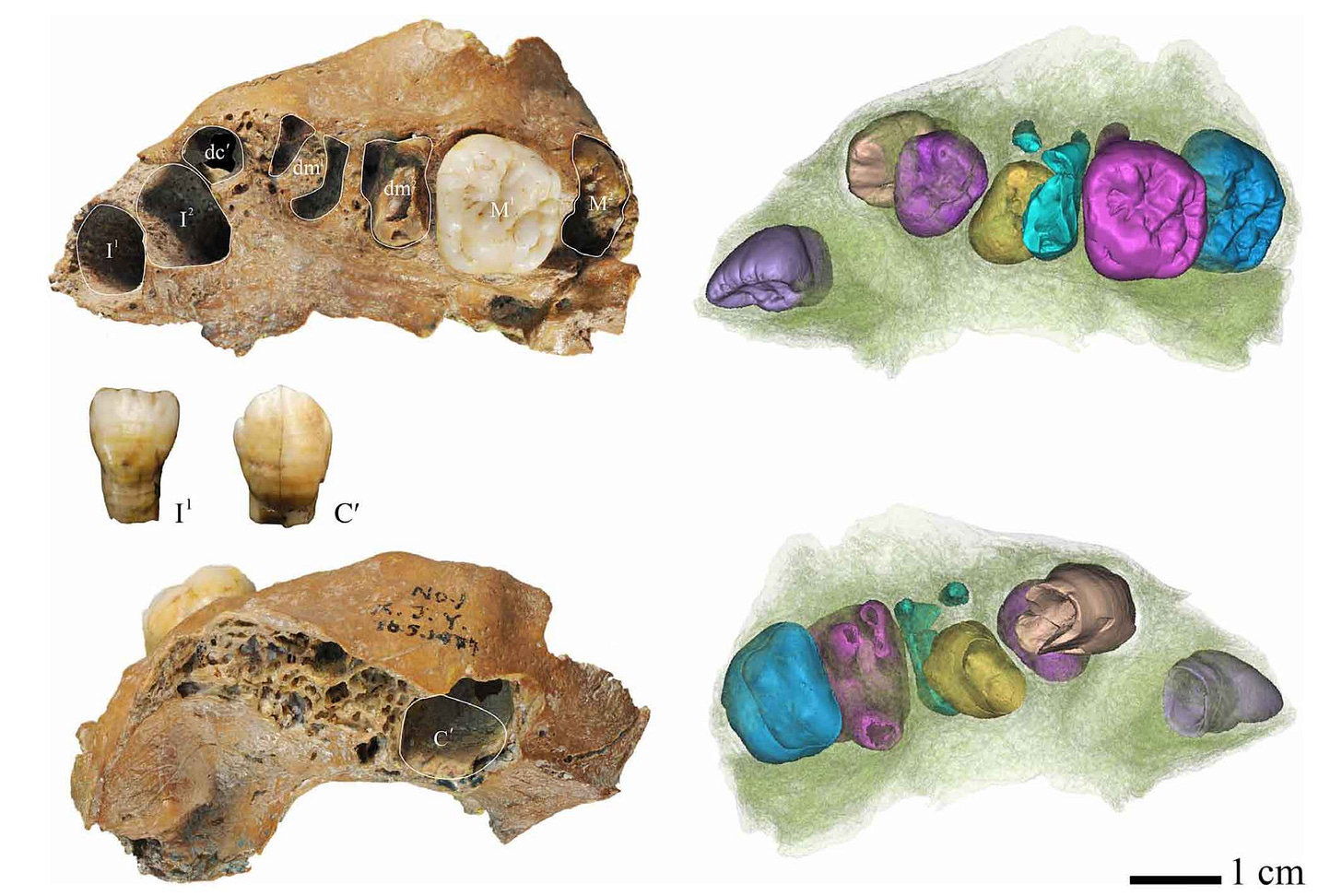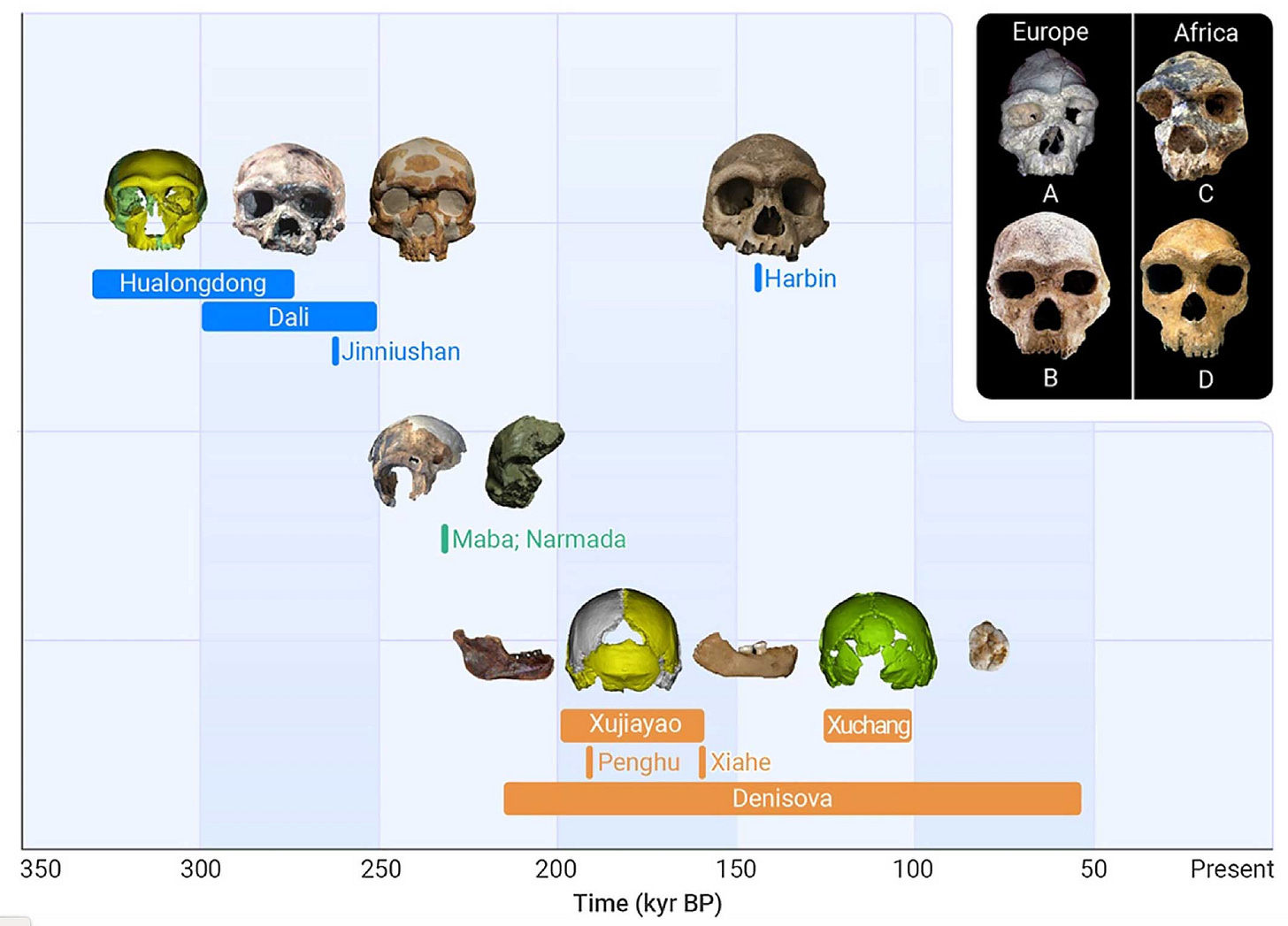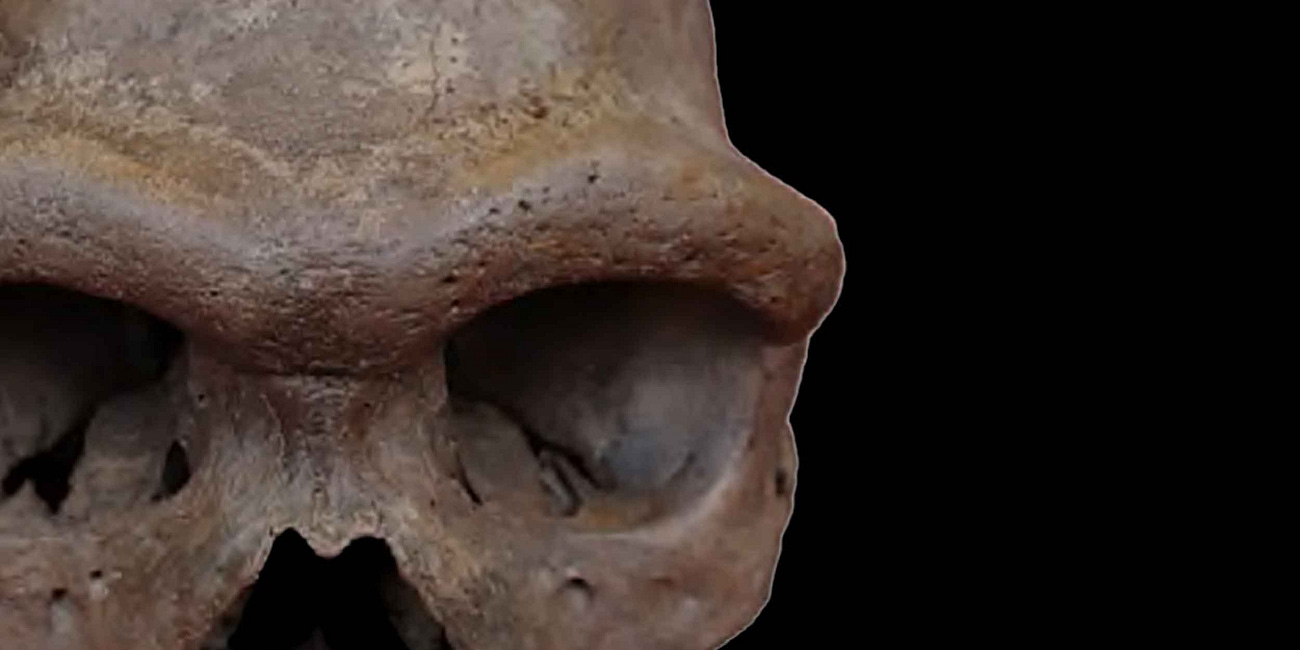Julurens: a new cousin for Denisovans and Neanderthals
A new study suggests that the Middle Pleistocene record in China includes more groups than have previously been recognized.
The human evolution record of China and mainland southeast Asia has seen a lot of action during the last decade. Back when I was a student, some European and American archaeologists held a stereotype that China had been a Pleistocene backwater, a place where Homo erectus hung on later than other places using only simplistic chopping tools. But that stereotype was based on poor evidence and a lack of familiarity with research that was happening in China.
Chinese researchers saw a clearer picture. Scientists like Xinzhi Wu and Lanpo Jia documented ways that the Middle Pleistocene fossils did not seem to fit the distinctions once drawn among Homo erectus, Neanderthals, and recent humans. Those ideas contributed to the idea of Multiregional Evolution, which saw genetic exchanges between regions and continuity within regions as two aspects of a network of populations spanning Africa and Eurasia. Wu wrote about the evolution of these populations as a river network with divergence and merging of streams.
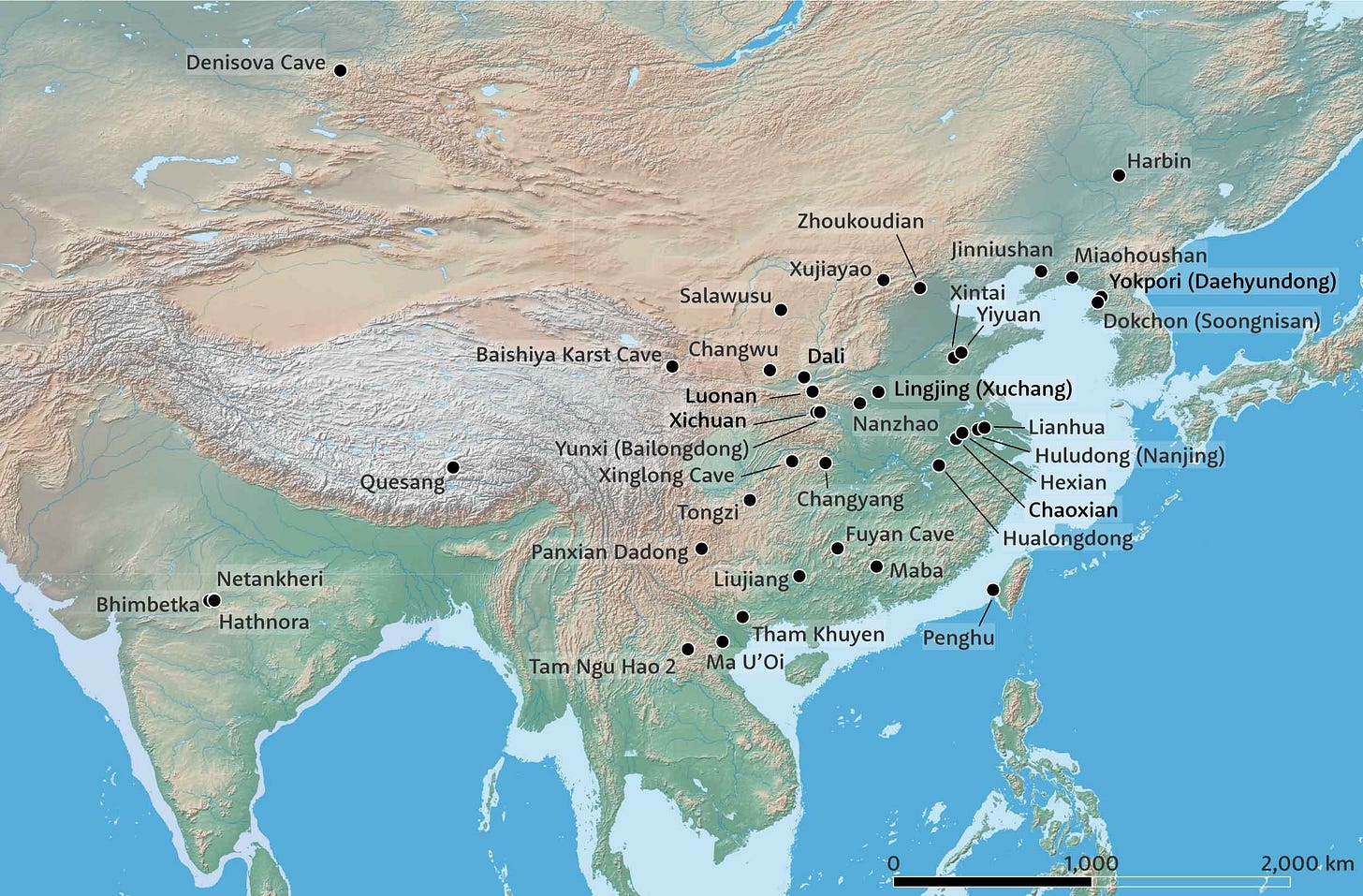
Recent discoveries have added much to scientists' understanding of ancient populations of east and southeast Asia. A better chronology has come from innovations in cosmogenic burial aging, combined U-series-ESR, and optically stimulated luminescence (OSL) dating. DNA evidence from Middle Pleistocene sites in central Asia and Europe has also transformed the picture in some important ways. Especially important is the previously-unknown diversity represented at Denisova Cave. But the anatomical variation of the so-called Denisovans is mostly unknown, while direct DNA evidence has so far eluded researchers working with fossils of Middle Pleistocene age in China. This has left some researchers and the media asking: Which fossils will turn out to be the real Denisovans?
But many scientists don't subscribe to the idea that the fossil record of China should be understood through an Altai lens. A 2024 article from Xiujie Wu and Christopher Bae presented a new look at some fossils of the later Middle Pleistocene. They focused on fossil samples from Xujiayao in north China and Xuchang in central China. These fossils, which date to between 220,000 and 100,000 years ago, contrast with the so-called “Dragon Man” skull from Harbin and other similar remains. Wu and Bae suggested that the Xujiayao and Xuchang fossils may be something different, calling them the Julurens—a name that means “big heads”. In an article later the same year, Bae and Wu upgraded their suggestion to the species level, naming the group Homo juluensis.
Who were the Julurens? Here I give a quick rundown of the key fossils. I also dive into the broader question of how variation in the fossil record may relate to the DNA evidence, especially the Denisovans.

Xujiayao
The Xujiayao site is at the border between Hebei Province and Shanxi Province in northern China, within the geological area known as the Nihewan Basin. Before around 300,000 years ago a lake filled part of the basin. Streams dumped sediments here as they flowed into the lake throughout much of the Pleistocene, and ancient people lived around the lake shores. Today the Sanggan River drains this basin between mountain ranges and the Xujiayao village and the nearby Houjiayao village lie upon on one of its tributaries. Near the villages lie exposed more than 20 meters of Pleistocene sediments including archaeological and fossil material in several places. Most people who have written about these sites use the name Xujiayao, but some have used Houjiayao and others Xujiayao/Houjiayao.
The hominin site was first identified in 1974 and excavations during the remainder of the 1970s uncovered more than 10,000 stone artifacts and twenty-one hominin fossils, all fragments of skull or teeth. These come from the later part of the Middle Pleistocene between 250,000 and 130,000 years ago. The present interpretation is that the hominin fossils and artifacts are in sediments of a meandering river after the Nihewan lake receded, probably after 250,000 years ago and before 160,000 years ago.
I always love fragmentary samples of fossils because broken fossils pose interesting challenges. Wu and Bae review these fossils in their article, and earlier this year Xiujie Wu provided some new descriptions in a Chinese language article. The most complete of the skulls is Xujiayao 6, which has large parts of both parietal bones and conjoining occipital, the three parts unearthed in three different field seasons at the site. What remains is enough to give an idea of the size of the skull and shape of the back part of it. The skull was big: With an estimated volume of 1700 ml, it is the largest known for any hominin of its time. While the brain was larger than those of most recent people, the skull was shaped very differently from them. It was markedly wider at its base, and limited in skull height. Other cranial bones from the site represent at least 10 individuals in total, but are all fragments. The vault fragments also reflect large cranial size with bones generally thicker than in recent human skulls.
Xujiayao 1 is the left side of a child's upper jaw, preserving many of the permanent teeth within it. Three other isolated teeth of other individuals add to the dental picture. The shovel-shaped incisor is a link to much earlier teeth from Zhoukoudian, although Wu and Bae mention that the crown's curved shape resembles the shape of some Neanderthal incisors. All the teeth are big, the premolars have asymmetrical outlines, the first molar is not square but has a trapezoid-like shape with a narrower distal end, and the molar roots diverge markedly. An analysis by Song Xing and collaborators showed that the dental development of this child was on schedule with recent humans, the earliest known fossil in China to show this pattern.
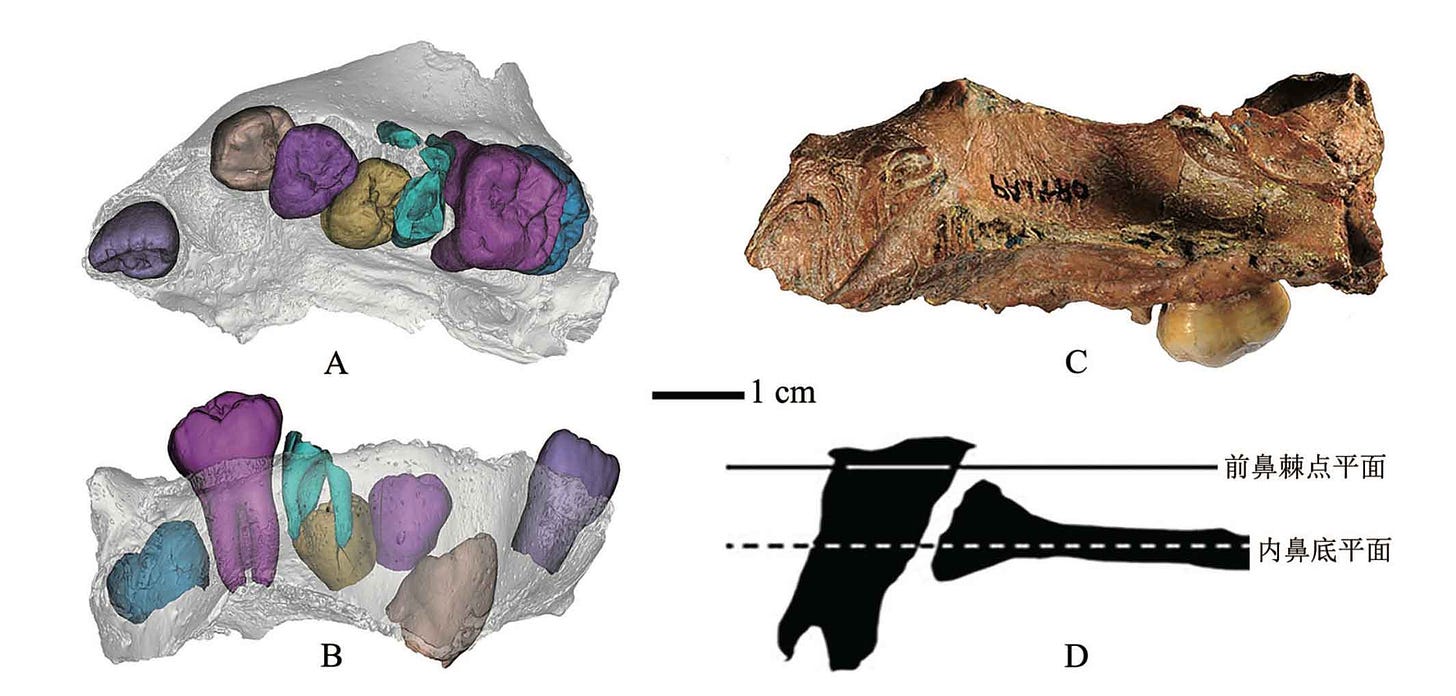
Other fossils provide some valuable hints. Xujiayao 14 is a wide and fairly short mandibular ramus, with an asymmetrical mandibular notch. Xujiayao 11 preserves parts of the parietal bones, including an enlarged foramen that would have been a patent opening in the skull of the individual when alive.
Over the decades since these fossils were unearthed, their fragmented state limited the kinds of conclusions that researchers could draw. Early studies by Lanpo Jia and coworkers, and by Maolin Wu, made clear that the remains did not belong to a Zhoukoudian-like Homo erectus, at the same time underlining their differences from recent people.
Xuchang
Xuchang county is in Henan Province, south of Shangxi, and the fossil skulls numbered as Xuchang 1 and 2 come from an open-air site inside of the town of Lingjing. The Lingjing site was a spring-fed pond that became filled with sediments during the later Pleistocene, as described by Zhan-Yang Li and coworkers. Artifacts and fossil bone were noticed from the site during the 1960s, and systematic investigation started after 2005 when the spring activity reduced and sediments desaturated.

Archaeologists found fragments of at least four ancient human skulls broken and scattered across a horizontal level, layer 11 at the site, determined by OSL to be between 125,000 and 105,000 years old. At that age, the Xuchang skulls are probably close to 100,000 years later than the Xujiayao fossils. In western Eurasia at around the same time lived the Neanderthals from Krapina, Croatia, and the early modern human fossils from Skhūl and Qafzeh, Israel. To the south, the large collection of fossil skulls from Ngandong, Indonesia, also lived around this same time.
Xuchang 1, which is the most complete of the skulls, has an endocranial volume around 1800 ml. That's the size of the largest-known Neanderthal skulls and larger than most living people. Xuchang 2 is less complete, preserving only the back of the skull, and it is somewhat smaller in size, closer to average for a living person or Neanderthal. Both are widest closer to the base and do not have the high, rounded shape of recent humans. Still, the back of the Xuchang 2 skull is more similar in shape to Neanderthal and modern human crania than earlier Chinese Middle Pleistocene fossils, as concluded in a research study published last year by Yameng Zhang and Zhanyang Li.

The description of the Xuchang skulls pointed to some similarities with Neanderthals. Xuchang 2 has a small depression at the back of its skull, just above the main attachment area of the neck muscles, which is called a suprainiac fossa. This is something that many Neanderthal skulls show, although anthropologists disagree about whether it denotes any special relationship. The study also points to some internal features of the semicircular canals.
“The temporal semicircular canals in both crania exhibit relatively small anterior canal radii and more superior lateral versus posterior canals, a pattern evident in most Neandertals and known elsewhere only in the early Late Pleistocene eastern Asian Xujiayao 15 temporal bone.”—Zhan-Yang Li and coworkers
This part of the inner ear has become more a part of studies of ancient hominin anatomy over the last 20 years as microCT studies of fossils have become more routine. But comparative samples of humans and other fossils needed to interpret the fossils are still sparse. The study of the Xuchang crania did not include the Dali skull, for example, and the Xuchang skulls do fall within the variation of recent people in their semicircular canal properties.
Julurens and Dragon People
The evidence from Xujiayao and Xuchang has its limits. Between them, the sites present only partial evidence from the face or mandible and none from the postcranial skeleton. Different parts of different fossils don't make for easy comparisons. The word “mosaic” is often used in comparisons of fossils these days, but really just means that a fossil may share some traits with one group, and some traits with other groups. Sorting out the relationships requires us to consider which traits are derived, and may therefore provide evidence of a uniquely shared evolutionary history. That's hard when the ancestors and more distant relatives of all these fossils may be less well known than they are.

Wu and Bae added up all the traits they could observe and concluded that they could not easily ascribe the Xujiayao pattern of features to the same group as most other Chinese Middle Pleistocene fossils. The found that the traits that seem to connect the Xujiayao and Xuchang fossils to the other Middle Pleistocene crania from the region, including the Dali, Hualongdong, Jinniushan, and Harbin skulls, mostly are also found more broadly in later H. erectus and archaic humans from other regions. At the same time, the Xujiayao and Xuchang fossils share some traits that have been interpreted as derived in Neanderthals, which are not in other fossils from eastern Asia. And although the brain sizes of Hualongdong, Dali, Jinniushan, and Harbin have a bigger average than H. erectus (and in fact are similar to recent humans), the volumes of the Xujiayao 6 and Xuchang 1 skulls are bigger still.
One small group of fossils did impress Wu and Bae as possibly similar to the Xujiayao teeth and mandible fragment: the fossils identified as Denisovans. They mention fossils from Denisova Cave itself as well as the Xiahe mandible from Baishiya Karst Cave, which previous research has aligned with the Denisova Cave “Denisovan” group based on collagen sequence similarity and sediment DNA from the site. Wu and Bae recognize that these Denisovan-identified fossils include some large and complex molars like the Xujiayao teeth, and the Xiahe mandible overlaps in morphology with the Xujiayao 14 mandible fragment. To this group they add the Penghu 1 mandible, dredged from the Taiwan Strait, the identity and exact age of which remains unknown.
Wu and Bae are not proposing that this group was isolated or different at a species level from the others. They instead consider that the pattern of morphology may result from genetic exchanges both among groups within China and with other regions further afield.
“It is quite possible that this population represents gene flow between Asian H. erectus, and possibly H. antecessor, H. bodoensis, and/or early Neanderthals, supporting the idea of continuity with hybridization as a major force shaping human evolution in eastern Asia during the late Middle and early Late Pleistocene.”—Xiujie Wu and Christopher Bae
As I thought about this new study, I found it valuable to re-read a short article published last year by Bae, Wu, and other colleagues in The Innovation. In that paper, Bae and his collaborators recount the “push, primarily by Western paleoanthropologists” to assign much of the Middle Pleistocene hominin fossil record into a single group, which many would name Homo heidelbergensis. But in their piece, they argue that the Chinese record does not fit well into such a framework. They discuss some of the weaknesses of this idea, and defend the idea that the Harbin skull and possibly others represent a different population, which they recognize as Homo longi—the Longrens, or Dragon People.
At the same time, these researchers recognize that H. longi may not include every fossil. They distinguish Xujiayao and Xuchang, grouping these with the Denisova and related fossils in the same way that Wu and Bae propose in their newer study. They also distinguish the partial skull from Maba, which fits neither of the other groups well but has some similarities with the partial skull from the Hathnora site on the Narmada River, India.
In my opinion, Bae and collaborators have a good case for distinguishing the Chinese fossil record from the fossils from Africa and western Eurasia across this time. Focusing closely on possible groupings or differences within the record from China is a good idea. The Xujiayao and Harbin fossils may overlap in age but differ in morphology, and they may well reflect different ancestry patterns.
In a preprint released in 2024, Xiaobo Feng and coworkers considered the relationships of many of these fossils. The aim of the study—still under review as of this writing—was to contextualize a new reconstruction of the Yunxian 2 cranium, usually attributed to Homo erectus. In the view of Feng and collaborators, Yunxian 2 may be more closely connected with Homo longi and not H. erectus. Their analysis is similar to the earlier study by Xijun Ni and coworkers that supported the Homo longi diagnosis, using derived traits to generate a phylogeny of individual fossils. The Xuchang 1 fossil is placed with Neanderthals in the analysis, which counts against the idea of a Juluren group. But Xujiayao does cluster with Denisova, Xiahe, and Penghu, all four nested within a group that includes other Middle Pleistocene fossils from China.

I like the analysis because the placement of a fossil on the tree depends on the derived traits it shares with other fossils, and that's exactly the evidence that matters. Still, the tree does not admit for the possibility of gene flow, and that's a significant drawback. If the fossils belong to a reticulate network of populations, the tree won't necessarily reflect their relationships accurately.
Without taking the tree entirely at face value, I suggest two ways of looking at the Xujiayao-Xiahe-Denisova group. If the Harbin skull defines the Longrens, then all the later Middle Pleistocene fossils might belong to that group, with the Julurens nested a subgroup within it. Or the Longrens might only include the Harbin, Dali, Maba, Jinniushan, and Hualongdong fossils, with Julurens considered separately.
Julurens and Denisovans
If the Xujiayao group includes Denisova Cave fossils and the Xiahe mandible, probably most people wonder why this group needs a different name. Why would the name of this group not just be “Denisovans”?
It is true that species names must follow certain strict rules, including the rule of priority. If two groups of fossils with different names are shown to belong to the same species, the earlier name is the one that should be used.
But a name like “Denisovan” is not a species name.
Names are important both in evolutionary biology and in anthropology. A name is a mental tool that enables us to communicate with other people about a concept. We define names to be useful. And if a name leads to confusion or misunderstandings, we may either redefine it or recommend to everyone that it be discarded.
The name “Denisovan” was coined by David Reich and collaborators in 2010 when they realized that the Denisova 3 genome represented a group deeply diverged from Neanderthal genomes known at that time. They drew a deliberate parallel between “Neanderthal”—named for the first place a Neanderthal fossil was recognized as a different group from recent humans—and “Denisovan”. At the same time, Reich and coworkers demonstrated the presence of Denisova 3-like ancestry in the genomes of living people in Papua. Later research showed that similar ancestry was very widespread at a low level across Asia and a higher level in island southeast Asia and Australia.
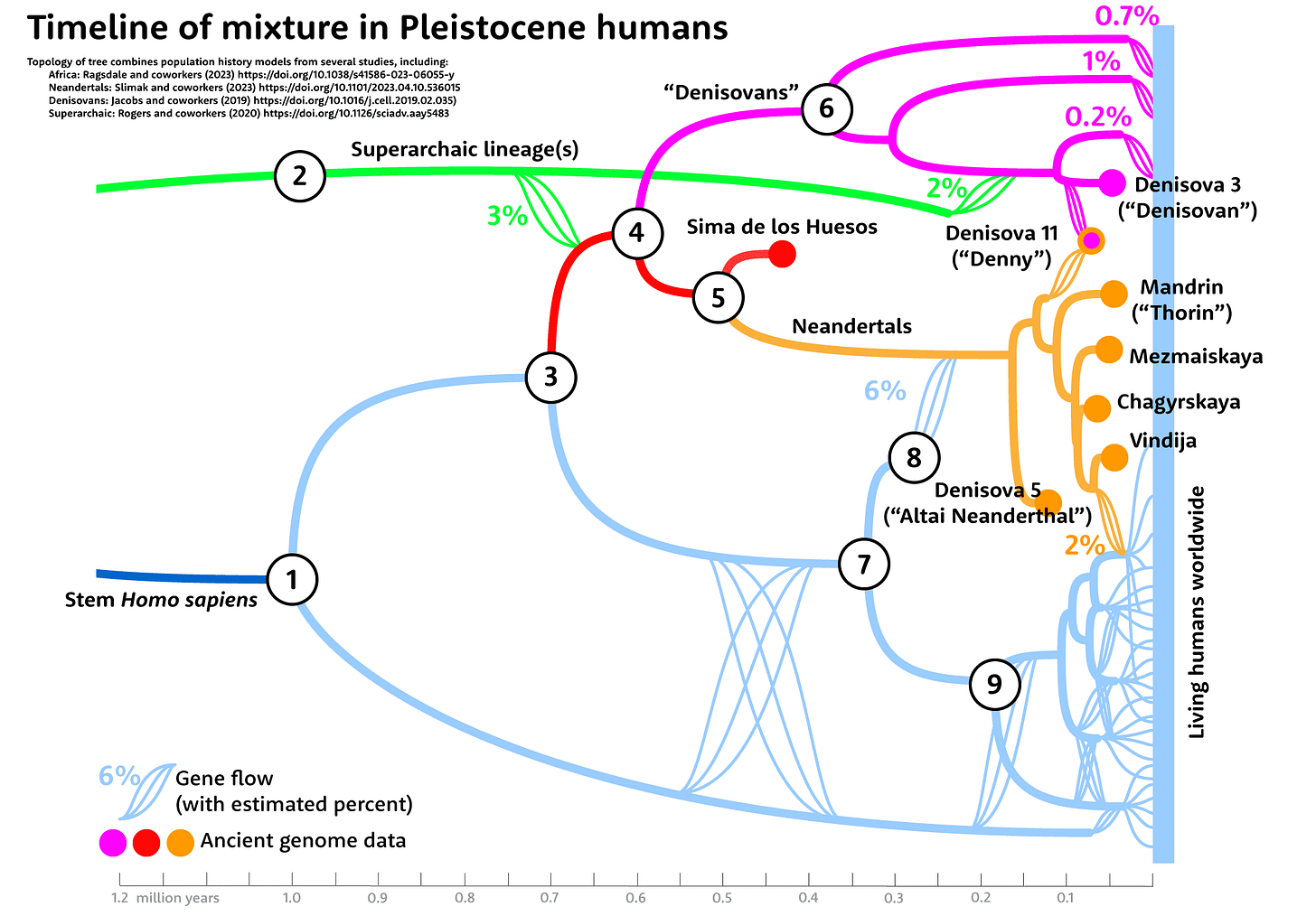
Since 2010, our understanding has deepened. The group we call Neanderthals was a deeply structured group of lineages. Early representatives like the sample from Sima de los Huesos, Spain, lacked ancestry inputs from Africa that were important to the makeup of later groups. The Denisova 5 “Altai Neanderthal” genome came from a lineage strongly diverged from later Neandertals both in Europe and Central Asia. Last year, Ludovic Slimak and coworkers released information about the “Thorin” Neanderthal individual from Mandrin, France, a fossil from another deeply diverged lineage.
These networks of relationships pose communication challenges beyond the scope of today's terminology. Researchers use the term “Neanderthal” for almost every fossil from western Eurasia, conveying the appearance that they all were part of one population. In reality these fossils belonged to a loose network of groups with many inflows and outflows, sharing a deep common ancestry but with long-separated branches. By coining names like “Thorin lineage” and “Altai Neanderthals”, researchers are starting to move beyond the limitations of the 170-year-old name. Groups that are early representatives of the Neanderthal genomic lineage, such as the Sima de los Huesos sample, Arago, and Petralona fossils, are so morphologically different from later Neanderthals that many researchers once unflinchingly called them a different species. They are not different species. But it would probably help communication to give them a name more specific than “Middle Pleistocene Homo” or “early Neanderthals”. Non-Linnaean names can be valuable for expressing distinctions below the species level, as long as the referent is clear.
What's true of the name “Neanderthal” is doubly so for “Denisovan”. So far scientists cannot assess the anatomy of Denisova-like groups of island southeast Asia. But the groups scientists have been calling “Denisovans” were even more deeply structured than Neanderthals. Some of the introgressing groups of southeast Asia had diverged from the ancestors of Denisova 3 as early as 350,000 years ago. The central Asian groups themselves were diverse over the 200,000 years they are represented in Denisova Cave. Those groups sometimes mixed with Neanderthals and at least once with the ancestors of present-day east Asian people. The distant ancestors of Denisova 3 also include another deeply-diverged “superarchaic” group, neither Neanderthal nor Denisovan. It's a complicated picture with many groups, mixing at different times and places. Calling all of them “Denisovans” may say something true about their deep common ancestry. But the single name obscures the long histories that gave rise to their variation, their diverse mixtures, and their cultures. These groups will have different names, once scientists have learned enough about them.
After the discovery of the Denisova 3 genome within its tiny finger bone, the media in Europe and the U.S. framed the study of this group as a whodunnit. In 2025 work on ancient proteins and mitochondrial DNA by Qiaomei Fu and collaborators showed that the Harbin skull was part of a Denisova-like population.
For many researchers in China this was no surprise. The Denisovan name, from their point of view, could exist only because of a temporary absence of correlation between DNA and the fossil record. For them, the question was not which fossils would give a face to the Denisovans, but instead which already-known fossil will give its name to the genomes.
Today it is clear that the Harbin skull, the Penghu 1 mandible, and the Xiahe fossil material are all part of that same group. Denisovans are Longrens in that sense.
I think the record is more expansive than most specialists have been assuming. The genetic data from different individuals within Denisova Cave shows diversity almost as deep as between the most different living humans. Maybe calling all these groups by the same name might make some sense as a contrast to recent humans. But a single name— whether “Denisovan” or “Longren”—may inhibit our understanding of the true pattern of ancient variation.
So I see the name Juluren not as a replacement for Denisovan, but as a way of referring to a particular group of fossils and their possible place in the network of ancient groups. The Xujiayao sample represents people who lived long before Denisova 3, who made very different artifacts and experienced different ecological conditions. I think it's very plausible that the groups were relatives but I suspect they were as different as the Altai Neanderthals and Thorin lineage. A different name within a broader grouping seems helpful, even if the Denisova fossils turn out to be close relatives of Xujiayao. A different name will be even more valuable if, as Wu and Bae suggest, the Xujiayao and Xuchang fossils do indeed reflect a mixture of ancestry from Neanderthals, earlier Chinese Middle Pleistocene people, and possibly others.
Julurens. You may find the name grows on you.
Notes: Fossil hominins in China have been assigned names in various ways, which can make it hard to remember which fossils come from which places. Archaeological and fossil material may be found in caves or geological features such as river terraces or eroding loess deposits. Local communities often have names for these features and archaeologists often adopt those names for sites. Or archaeologists may use the name of a nearby village as a site name. Hominin fossils sometimes are numbered based on the site name, which is the case for Xujiayao. On the other hand, many hominin fossils are given the name of the county or other administrative unit where the site is located. Hence the Xuchang fossils are from the Lingjing site, and the Xiahe mandible from Baishiya Karst Cave.
Shi-Xia Yang and collaborators published a review of the geology and sites of the Nihewan Basin a few years ago, and this is a very helpful guide to the archaeology and fossil material of the region.
I thought about whether to discuss the idea of species names more in this post, and I opted against it. This was already a long discussion. I wrote about the discovery that the Harbin skull has Denisova-like DNA in a later post, where I discuss my own approach to their species classification as part of Homo sapiens:
The humanity of a new Denisovan
Last week a team led by Qiaomei Fu revealed a partial mitochondrial DNA sequence from the Harbin skull. In a second paper, Fu and her team also described protein evidence from the skull. Together, the mtDNA and protein evidence embed the Harbin individual within a broader lineage that we know as
References
Ao, H., Liu, C.-R., Roberts, A. P., Zhang, P., & Xu, X. (2017). An updated age for the Xujiayao hominin from the Nihewan Basin, North China: Implications for Middle Pleistocene human evolution in East Asia. Journal of Human Evolution, 106, 54–65. https://doi.org/10.1016/j.jhevol.2017.01.014
Bae, C. J., Liu, W., Wu, X., Zhang, Y., & Ni, X. (2023). “Dragon man” prompts rethinking of Middle Pleistocene hominin systematics in Asia. The Innovation, 4(6), 100527. https://doi.org/10.1016/j.xinn.2023.100527
Bae, C. J., & Wu, X. (2024). Making sense of eastern Asian Late Quaternary hominin variability. Nature Communications, 15(1), 9479. https://doi.org/10.1038/s41467-024-53918-7
Chen, F., Welker, F., Shen, C.-C., Bailey, S. E., Bergmann, I., Davis, S., Xia, H., Wang, H., Fischer, R., Freidline, S. E., Yu, T.-L., Skinner, M. M., Stelzer, S., Dong, G., Fu, Q., Dong, G., Wang, J., Zhang, D., & Hublin, J.-J. (2019). A late Middle Pleistocene Denisovan mandible from the Tibetan Plateau. Nature, 569(7756), Article 7756. https://doi.org/10.1038/s41586-019-1139-x
Feng, X., Lu, D., Gao, F., Fang, Q., Feng, Y., Huang, X., Tan, C., Zhou, H., Li, Q., Zhang, C., Stringer, C., & Ni, X. (2024). The phylogenetic position of the Yunxian cranium elucidates the origin of Dragon Man and the Denisovans(p. 2024.05.16.594603). bioRxiv. https://doi.org/10.1101/2024.05.16.594603
Li, Z.-Y., Wu, X.-J., Zhou, L.-P., Liu, W., Gao, X., Nian, X.-M., & Trinkaus, E. (2017). Late Pleistocene archaic human crania from Xuchang, China. Science, 355(6328), 969–972. https://doi.org/10.1126/science.aal2482
Ni, X., Ji, Q., Wu, W., Shao, Q., Ji, Y., Zhang, C., Liang, L., Ge, J., Guo, Z., Li, J., Li, Q., Grün, R., & Stringer, C. (2021). Massive cranium from Harbin in northeastern China establishes a new Middle Pleistocene human lineage. The Innovation, 2(3). https://doi.org/10.1016/j.xinn.2021.100130
Tu, H., Shen, G., Li, H., Xie, F., & Granger, D. E. (2015). 26Al/10Be Burial Dating of Xujiayao-Houjiayao Site in Nihewan Basin, Northern China. PLOS ONE, 10(2), e0118315. https://doi.org/10.1371/journal.pone.0118315
Wu, X., Pei, S.-W., Cai, Y.-J., Tong, H.-W., Li, Q., Dong, Z., Sheng, J.-C., Jin, Z.-T., Ma, D.-D., Xing, S., Li, X.-L., Cheng, X., Cheng, H., de la Torre, I., Edwards, R. L., Gong, X.-C., An, Z.-S., Trinkaus, E., & Liu, W. (2019). Archaic human remains from Hualongdong, China, and Middle Pleistocene human continuity and variation. Proceedings of the National Academy of Sciences, 116(20), 9820–9824. https://doi.org/10.1073/pnas.1902396116
Wu, Xiujie. (2024). Research progress on human fossils from the Xujiayao site in late Middle Pleistocene. Acta Anthropologica Sinica, 43(01), 5. https://doi.org/10.16359/j.1000-3193/AAS.2023.0044
Wu, Xiujie & Bae, Christopher J. (2024). Xujiayao Homo: A new form of large brained hominin in eastern Asia. PaleoAnthropology, 2024. https://paleoanthropology.org/ojs/index.php/paleo/libraryFiles/downloadPublic/18
Wu, X.-J., Bae, C. J., Friess, M., Xing, S., Athreya, S., & Liu, W. (2022). Evolution of cranial capacity revisited: A view from the late Middle Pleistocene cranium from Xujiayao, China. Journal of Human Evolution, 163, 103119. https://doi.org/10.1016/j.jhevol.2021.103119
Xing, S., Tafforeau, P., O’Hara, M., Modesto-Mata, M., Martín-Francés, L., Martinón-Torres, M., Zhang, L., Schepartz, L. A., de Castro, J. M. B., & Guatelli-Steinberg, D. (2019). First systematic assessment of dental growth and development in an archaic hominin (genus, Homo) from East Asia. Science Advances, 5(1), eaau0930. https://doi.org/10.1126/sciadv.aau0930
Zhang, Y., & Li, Z. (2023). Three-dimensional geometric morphometric study of the Xuchang 2 cranium. Journal of Human Evolution, 178, 103347. https://doi.org/10.1016/j.jhevol.2023.103347


